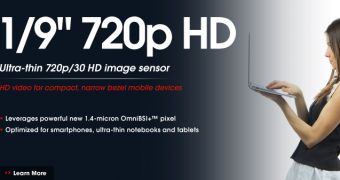There is a new HD image sensor in town, one that is specifically intended for compact products that can't fit any camera modules larger than 2.5mm in height.
It is OmniVision that has announced its latest ultra-compact, high-performance image sensor for small form factor consumer electronics.
The sensor in question is called OV9724 and can capture photos and video in quality of up to 720p, HD as it were (high-definition).
"The OV9724 further establishes OmniVision's role in defining the future of mobile imaging," said Nick Nam, director of product marketing at OmniVision.
"Enabled by our latest OmniBSI+ technology, the extremely small and low-power OV9724 allows manufacturers to integrate high-performance HD video into extremely slim devices at a highly competitive price point. It is also designed to satisfy all major industry standard performance and quality requirements currently prevailing in the market, offering customers an extensive range of options for use in advanced imaging systems."
For those who want an exact list of what devices can incorporate the OV9724, OmniVision's announcement mentions tablets, portable gaming systems, notebooks and smartphones, among others things.
Spec-wise, OV9724 relies on the 1.4-micron OmniBSI+ pixel architecture, which captures the aforementioned HD video at 30fps, or cropped VGA at 60 fps (frames per second).
There is also a one-lane MIPI interface, plus the serial camera control bus (SCCB) interface, which makes it possible to program image processing functions, like exposure control and defective pixel canceling.
Finally, the company offers the OVM9724, which is the OV9724 packaged in OmniVision's proprietary CameraCube format (4 x 3 x 2.5 mm). It will probably be used more often than the OV9724 in notebooks and tablets with thin bezels.
OmniVision intends to start shipping samples of both inventions in the second quarter of the year (April-June, 2012). In other words, consumer products that rely on them will take until Q3 or Q4 to show up.

 14 DAY TRIAL //
14 DAY TRIAL //